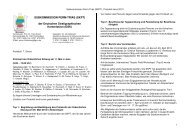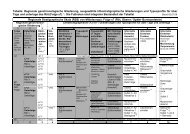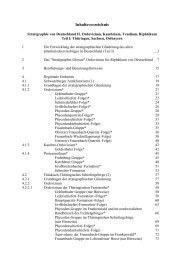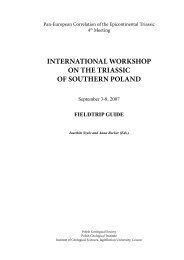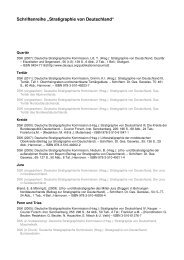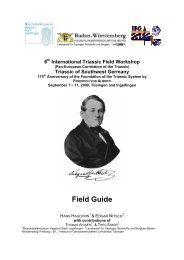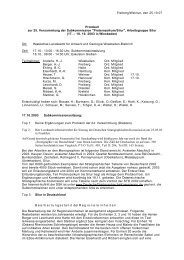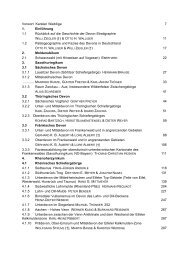International Field Workshop on 'The Triassic of eastern France'
International Field Workshop on 'The Triassic of eastern France'
International Field Workshop on 'The Triassic of eastern France'
You also want an ePaper? Increase the reach of your titles
YUMPU automatically turns print PDFs into web optimized ePapers that Google loves.
Figure IV.1: Lithostratigraphy, sedimentary envir<strong>on</strong>ment variati<strong>on</strong>s and rank <strong>of</strong> different A/S stratigraphic<br />
cycles in two wells characteristic <strong>of</strong> the <strong>eastern</strong> and western Paris Basin (after, Bourquin and Guillocheau,<br />
1996, modified). See Fig. IV.2 for locati<strong>on</strong>. After Bourquin and Guillocheau, 1996.<br />
Cycles (1) and (2) bel<strong>on</strong>g to the progradati<strong>on</strong>al hemi-cycle <strong>of</strong> the Scythian-Carnian major cycle, while<br />
cycles (3), (4) and (5) bel<strong>on</strong>g to the retrogradati<strong>on</strong>al hemi-cycle <strong>of</strong> the Carnian-Liassic major cycle (Figs. 1b<br />
and 2). These cycles are summarised in two secti<strong>on</strong>s: <strong>on</strong>e from East to West (Fig. III.2a) and the other from<br />
North to South (Fig. II.2b). In another study, detailed isopach maps <strong>of</strong> each <strong>of</strong> the five minor cycles are used<br />
to analyse the 3D evoluti<strong>on</strong> <strong>of</strong> the basin during this period (Bourquin et al., 1997). These maps show that<br />
local tect<strong>on</strong>ic activity has influenced the preservati<strong>on</strong> <strong>of</strong> the evaporitic and fluvial deposits. The major base-<br />
level cycles record variati<strong>on</strong>s in the rate <strong>of</strong> subsidence in time and space. The maximum rate <strong>of</strong> subsidence<br />
for the Scythian-Carnian cycle occurred in the east <strong>of</strong> the Paris Basin. During the Carnian-Liassic cycle, the<br />
areas <strong>of</strong> greatest subsidence shifted northwestwards. The shift marked the appearance <strong>of</strong> an independent<br />
Paris Basin which was no l<strong>on</strong>ger simply the western margin <strong>of</strong> the German Basin. This shift can be ascribed<br />
to large-scale wavelength tect<strong>on</strong>ic deformati<strong>on</strong> and produced an intra-’Marnes irisées supérieures’<br />
truncati<strong>on</strong>.<br />
4.2.1. Lettenkohle minor cycle or Ladinian - lower Carnian Cycle<br />
The Lettenkohle, which crops out in the <strong>eastern</strong> part <strong>of</strong> the Paris Basin, occur throughout the east and<br />
grade laterally into siliciclastic sediments in the extreme northeast <strong>on</strong>ly (Fig. 7). The Lettenkohle Formati<strong>on</strong><br />
grades westwards into the fluvial sediments <strong>of</strong> the D<strong>on</strong>nemarie Sandst<strong>on</strong>es, to the west <strong>of</strong> the Saint-Martin-<br />
de-Bossenay Fault (Figs. III.2, IV.1). Within these strata, are bioturbated clayst<strong>on</strong>es with occasi<strong>on</strong>al<br />
29



